Energy Management-Based Predictive Controller for a Smart Building Powered by Renewable Energy
Abstract
1. Introduction
2. The Smart Building-Integrated-Microgrid Modeling
2.1. The Solar PV Generators Modeling
2.2. Wind Turbine Generator
2.3. Energy Storage System Dynamics
2.4. Loads
2.5. Energy Exchanged on the Building’s Envelope
3. Building Energy Management Algorithm: The Tracking Control Problem
3.1. Objective Function
3.2. State Equations and Constraints
4. Application and Numerical Results
4.1. Case Study Description
4.2. Results and Discussion
5. Conclusions
Author Contributions
Funding
Acknowledgments
Conflicts of Interest
Nomenclature
| total walls’ area [m2] | |
| specific heat of water [kWh/l °C] | |
| inside air heat capacity [kWh/°C] | |
| thickness wall metering [m] | |
| module short circuit current [A] | |
| module maximum power current [A] | |
| solar irradiance [kW/m2] | |
| standard light intensity [kW/m2] | |
| rated power [kW] | |
| water storage volume [l] | |
| thermal resistance [°C /kW] | |
| module maximum power voltage [V] | |
| module open circuit voltage [V] | |
| serial number of modules [–] | |
| parallel number of modules [–] | |
| charging efficiency [–] | |
| discharging efficiency [–] | |
| non-controllable load reference [kW] | |
| temperature of water storage [°C] | |
| indoor temperature [°C] | |
| outside temperature [°C] | |
| indoor temperature reference [°C] | |
| temperature of cold water [°C] | |
| state of energy storage system [kWh] | |
| expected wind speed [m/s] | |
| charged power [kW] | |
| discharged power [kW] | |
| power purchased [kW] | |
| power sold [kW] | |
| electric power of micro-CHP [kW] | |
| thermal power of micro-CHP [kWh] | |
| power output of PV modules [kW] | |
| power output of wind turbine [kW] | |
| power balance [kW] |
References
- Bayliss, C.R.; Hardy, B.J. Smart grids. In Transmission and Distribution Electrical Engineering, 4th ed.; Elsevier: Amsterdam, The Netherlands, 2012; pp. 1059–1074. [Google Scholar]
- Ouammi, A. Optimal Power Scheduling for Cooperative Network of Smart Residential Buildings. IEEE Trans. Sustain. Energy 2016, 7, 1317–1326. [Google Scholar] [CrossRef]
- Wang, L.; Wang, Z.; Yang, R. Intelligent Multiagent Control System for Energy and Comfort Management in Smart and Sustainable Building. IEEE Trans. Smart Grids 2012, 3, 605–617. [Google Scholar] [CrossRef]
- Tian, P.; Xiao, X.; Wang, K.; Ding, R. A Hierarchical Energy Management System Based on Hierarchical Optimization for Microgrid Community Economic Operation. IEEE Trans. Smart Grid 2016, 7, 2230–2241. [Google Scholar] [CrossRef]
- Zhao, P.; Suryanarayanan, S.; Simões, M.G. An Energy Management System for Building Structures Using a Multi-Agent Decision-Making Control Methodology. IEEE Trans. Ind. Appl. 2013, 49, 322–330. [Google Scholar] [CrossRef]
- Sun, B.; Luh, P.B.; Jia, Q.; Jiang, Z.; Wang, F.; Song, C. Building Energy Management: Integrated Control of Active and Passive Heating, Cooling, Lighting, Shading, and Ventilation Systems. IEEE Trans. Autom. Sci. Eng. 2013, 10, 582–602. [Google Scholar]
- Vaghefi, S.A.; Jafari, M.A.; Zhu, J.; Brouwer, J.; Lu, Y. A Hybrid Physics-Based and Data Driven Approach to Optimal Control of Building Cooling/Heating Systems. IEEE Trans. Autom. Sci. Eng. 2016, 13, 600–610. [Google Scholar] [CrossRef]
- Lee, S.; Kwon, B.; Lee, S. Joint Energy Management System of Electric Supply and Demand in Houses and Buildings. IEEE Trans. Power Syst. 2014, 29, 2804–2812. [Google Scholar] [CrossRef]
- Chapman, A.C.; Verbic, G.; Hill, D.J. Algorithmic and Strategic Aspects to Integrating Demand-Side Aggregation and Energy Management Methods. IEEE Trans. Smart Grid 2016, 7, 2748–2760. [Google Scholar] [CrossRef]
- Althaher, S.; Mancarella, P.; Mutale, J. Automated Demand Response from Home Energy Management System Under Dynamic Pricing and Power and Comfort Constraints. IEEE Trans. Smart Grids 2015, 6, 1874–1883. [Google Scholar] [CrossRef]
- Yao, E.; Samadi, P.; Wong, V.W.S.; Schober, R. Residential Demand Side Management under High Penetration of Rooftop Photovoltaic Units. IEEE Trans. Smart Grid 2016, 7, 1597–1608. [Google Scholar] [CrossRef]
- Wang, Z.; He, Y. Two-stage optimal demand response with battery energy storage systems. IET Gener. Transm. Distrib. 2016, 10, 1286–1293. [Google Scholar] [CrossRef]
- Li, Y.; Han, Y. A Module-Integrated Distributed Battery Energy Storage and Management System. IEEE Trans. Power Electron. 2016, 31, 8260–8270. [Google Scholar] [CrossRef]
- Dagdougui, H.; Ouammi, A.; Sacile, R. Optimal Control of a Network of Power Microgrids Using the Pontryagin’s Minimum Principle. IEEE Trans. Control Syst. Technol. 2014, 22, 1942–1948. [Google Scholar] [CrossRef]
- Bersani, C.; Dagdougui, H.; Ouammi, A.; Sacile, R. Distributed Robust Control of the Power Flows in a Team of Cooperating Microgrids. IEEE Trans. Control. Syst. Technol. 2016, 25, 1473–1479. [Google Scholar] [CrossRef]
- Ouammi, A.; Dagdougui, H.; Dessaint, L.; Sacile, R. Coordinated Model Predictive-Based Power Flows Control in a Cooperative Network of Smart Microgrids. IEEE Trans. Smart Grid 2015, 6, 2233–2244. [Google Scholar] [CrossRef]
- Fotuhi-Firuzabad, H.F.M.; Moeini-Aghtaie, M. A Stochastic Multi-Objective Framework for Optimal Scheduling of Energy Storage Systems in Microgrids. IEEE Trans. Smart Grid 2017, 8, 117–127. [Google Scholar]
- Sturzenegger, D.; Gyalistras, D.; Morari, M.; Smith, R.S. Model Predictive Climate Control of a Swiss Office Building: Implementation, Results, and Cost–Benefit Analysis. IEEE Trans. Control Syst. Technol. 2016, 24, 1–12. [Google Scholar] [CrossRef]
- Ouammi, A.; Dagdougui, H.; Sacile, R. Optimal Control of Power Flows and Energy Local Storages in a Network of Microgrids Modeled as a System of Systems. IEEE Trans. Control Syst. Technol. 2015, 23, 128–138. [Google Scholar] [CrossRef]
- Dagdougui, H.; Ouammi, A.; Dessaint, L.; Sacile, R. Global energy management system for cooperative networked residential green buildings. IET Renew. Power Gener. 2016, 10, 1237–1244. [Google Scholar] [CrossRef]
- Zhang, D.; Li, S.; Sun, M.; O’Neill, Z. An Optimal and Learning-Based Demand Response and Home Energy Management System. IEEE Trans. Smart Grid 2016, 7, 1790–1801. [Google Scholar] [CrossRef]
- Sartori, I.; Napolitano, A.; Voss, K. Net zero energy buildings: A consistent definition framework. Energy Build. 2012, 48, 220–232. [Google Scholar] [CrossRef]
- Sesana, M.M.; Salvalai, G. Overview on life cycle methodologies and economic feasibility for nZEBs. Build. Environ. 2013, 67, 211–216. [Google Scholar] [CrossRef]
- Brambilla, A.; Salvalai, G.; Imperadori, M.; Sesana, M.M. Nearly zero energy building renovation: From energy efficiency to environmental efficiency, a pilot case study. Energy Build. 2018, 166, 271–283. [Google Scholar] [CrossRef]
- Yujiro, H.; Tomohiko, I.; Kei, G.; Tsuyoshi, F. Simulation-Based Evaluation of the Effect of Green Roofs in Office Building Districts on Mitigating the Urban Heat Island Effect and Reducing CO2 Emissions. Sustainability 2019, 11, 2055. [Google Scholar]
- Lei, Z.; Zhenwei, C.; Qing, H.; Peipei, Z. Investigating the Constraints to Buidling Information Modeling (BIM) Applications for Sustainable Building Projects: A Case of China. Sustainability 2019, 11, 1896. [Google Scholar]
- Sara, E.; Chro Hama, R.; István, K.; Bálint, B.; János, G. Model Simplification on Energy and Comfort Simulation Analysis for Residential Building Design in Hot and Arid Climate. Energies 2020, 13, 1876. [Google Scholar]
- Van-Hai, B.; Akhtar, H.; Hak-Man, K.; Yong-Hoon, I. Optimal Energy Management of Building Microgrid Networks in Islanded Mode Considering Adjustable Power and Component Outages. Energies 2018, 11, 2351. [Google Scholar]
- Il-Seok, C.; Akhtar, H.; Van-Hai, B.; Hak-Man, K. A Multi-Agent System-Based Approach for Optimal Operation of Building Microgrids with Rooftop Greenhouse. Energies 2018, 11, 1876. [Google Scholar]
- Carli, R.; Dotoli, M. Decentralized control for residential energy management of a smart users microgrid with renewable energy exchange. IEEE/CAA J. Autom. Sin. 2019, 6, 641–656. [Google Scholar] [CrossRef]
- Carli, R.; Dotoli, M.; Jantzen, J.; Kristensen, M.; Othman, S.B. Energy scheduling of a smart microgrid with shared photovoltaic panels and storage: The case of the Ballen marina in Samsø. Energy 2020, 198, 117188. [Google Scholar] [CrossRef]
- Carli, R.; Dotoli, M. Cooperative Distributed Control for the Energy Scheduling of Smart Homes with Shared Energy Storage and Renewable Energy Source. IFAC-PapersOnLine 2017, 50, 8867–8872. [Google Scholar] [CrossRef]
- Tasdighi, M.; Ghasemi, H.; Rahimi-Kian, A. Residential microgrid scheduling based on smart maters data and temperature dependent thermal load modeling. IEEE Trans. Smart Grid 2014, 5, 349–357. [Google Scholar] [CrossRef]
- Hosseini, S.M.; Carli, R.; Dotoli, M. A Residential Demand-Side Management Strategy under Nonlinear Pricing Based on Robust Model Predictive Control. In IEEE International Conference on Systems, Man and Cybernetics (SMC); IEEE: Piscataway, NJ, USA, 2019. [Google Scholar]
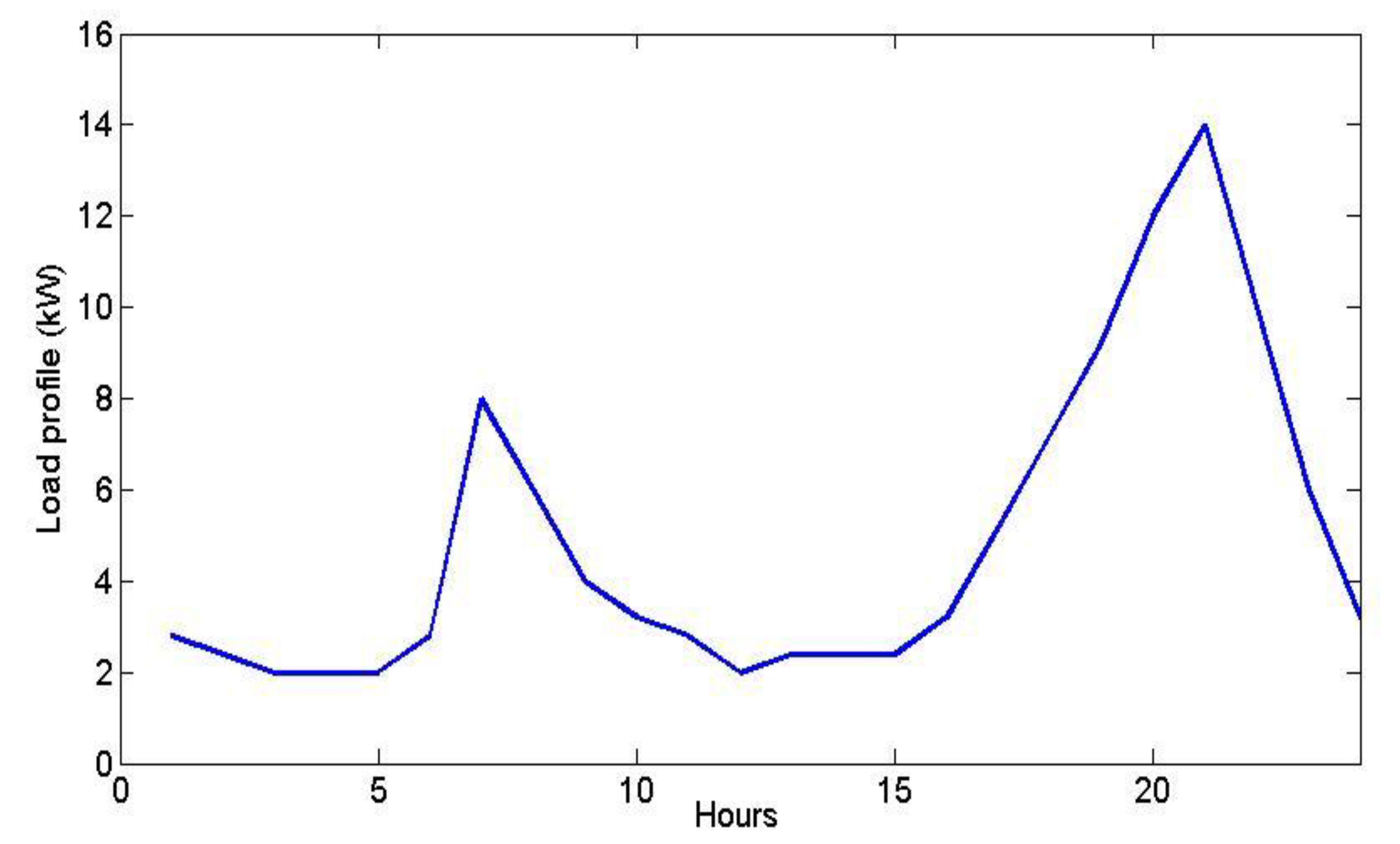
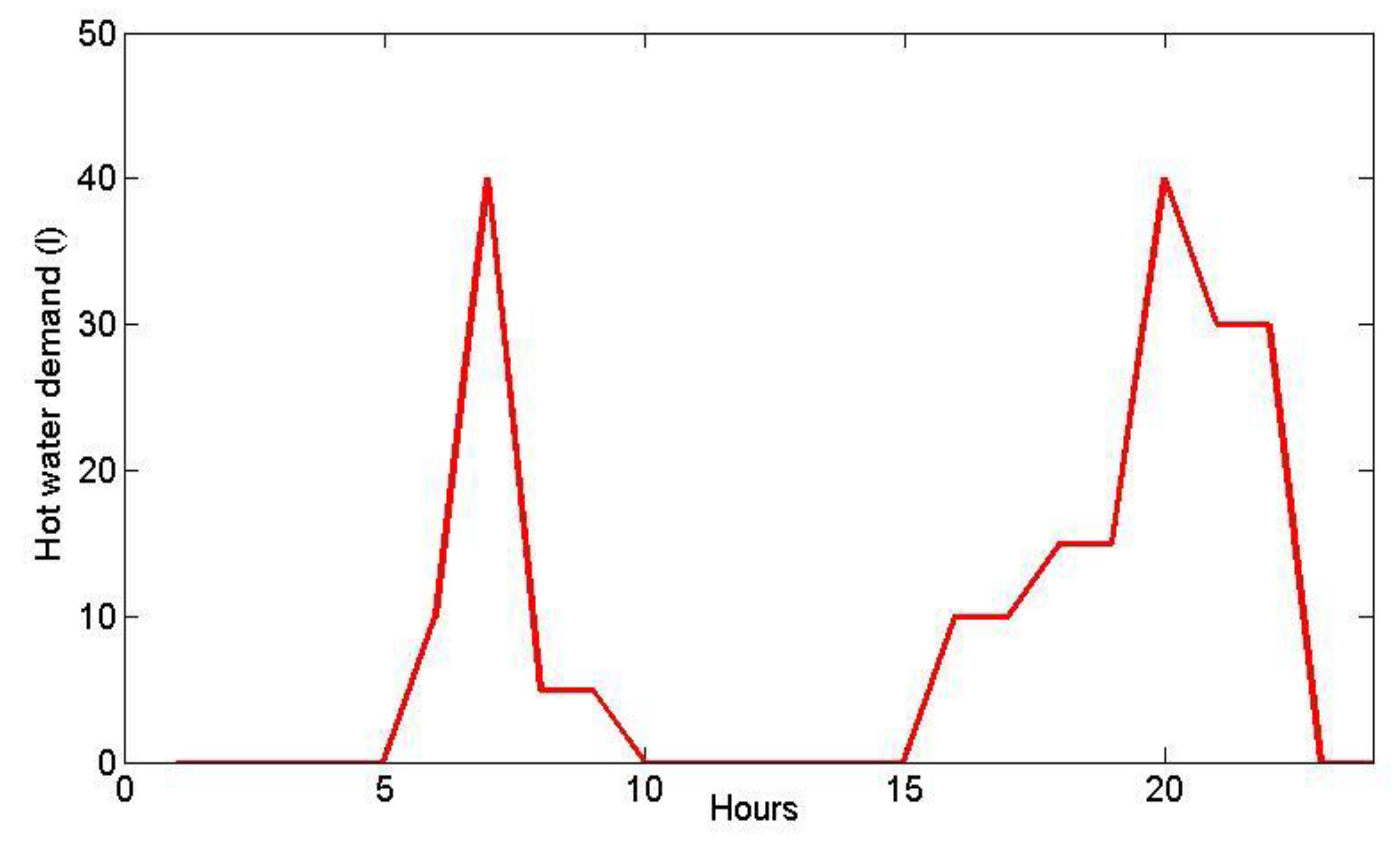

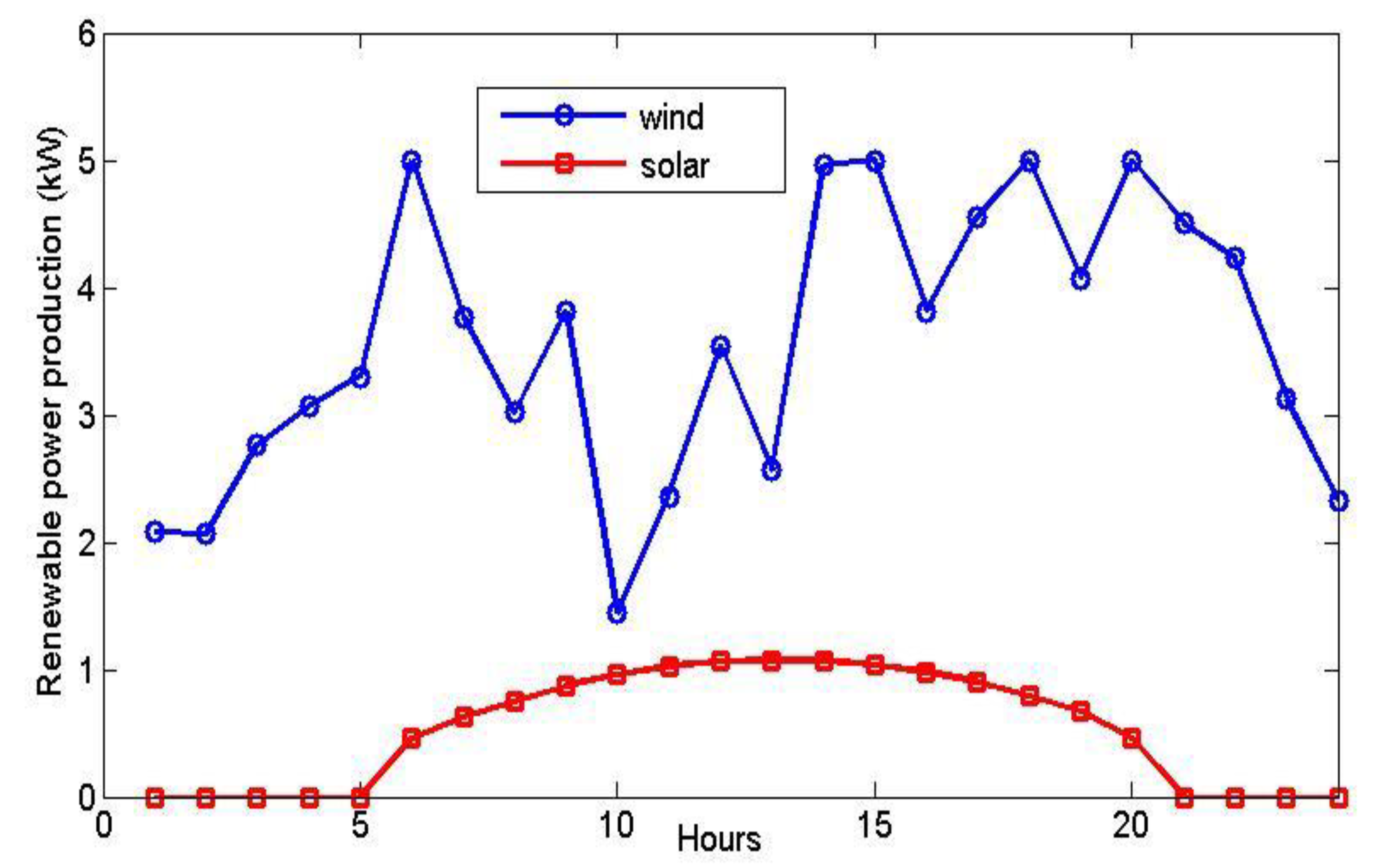

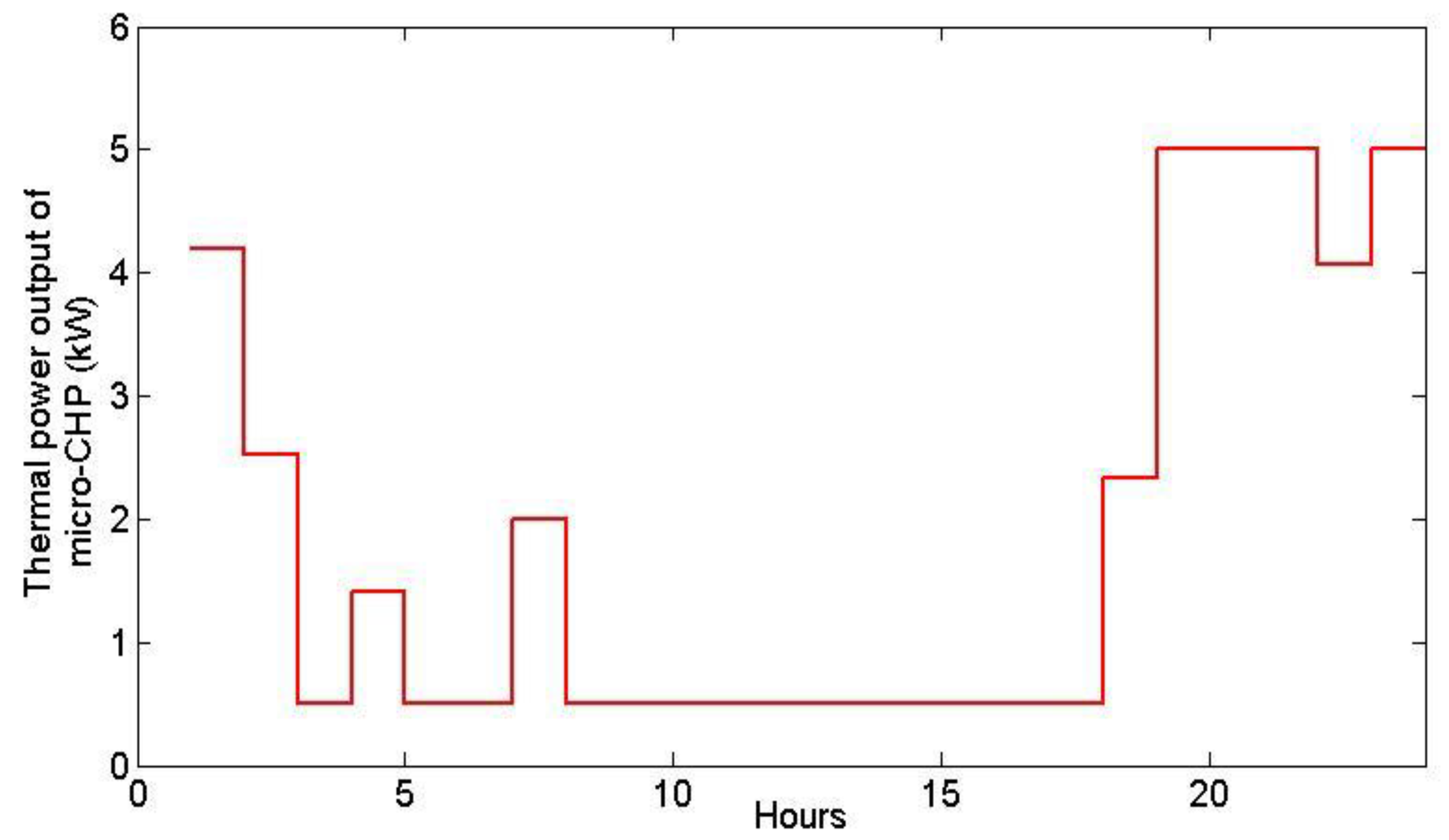
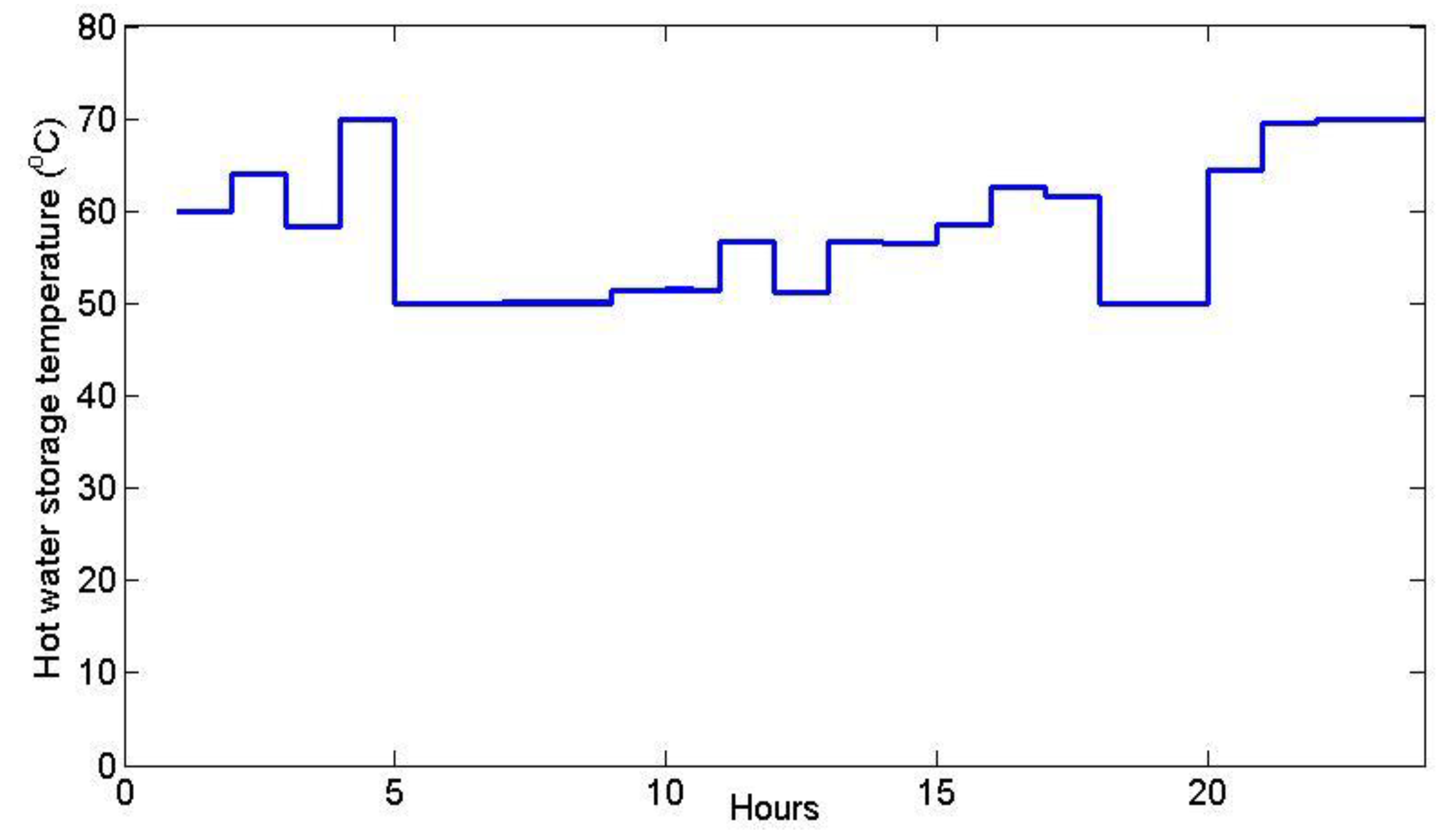
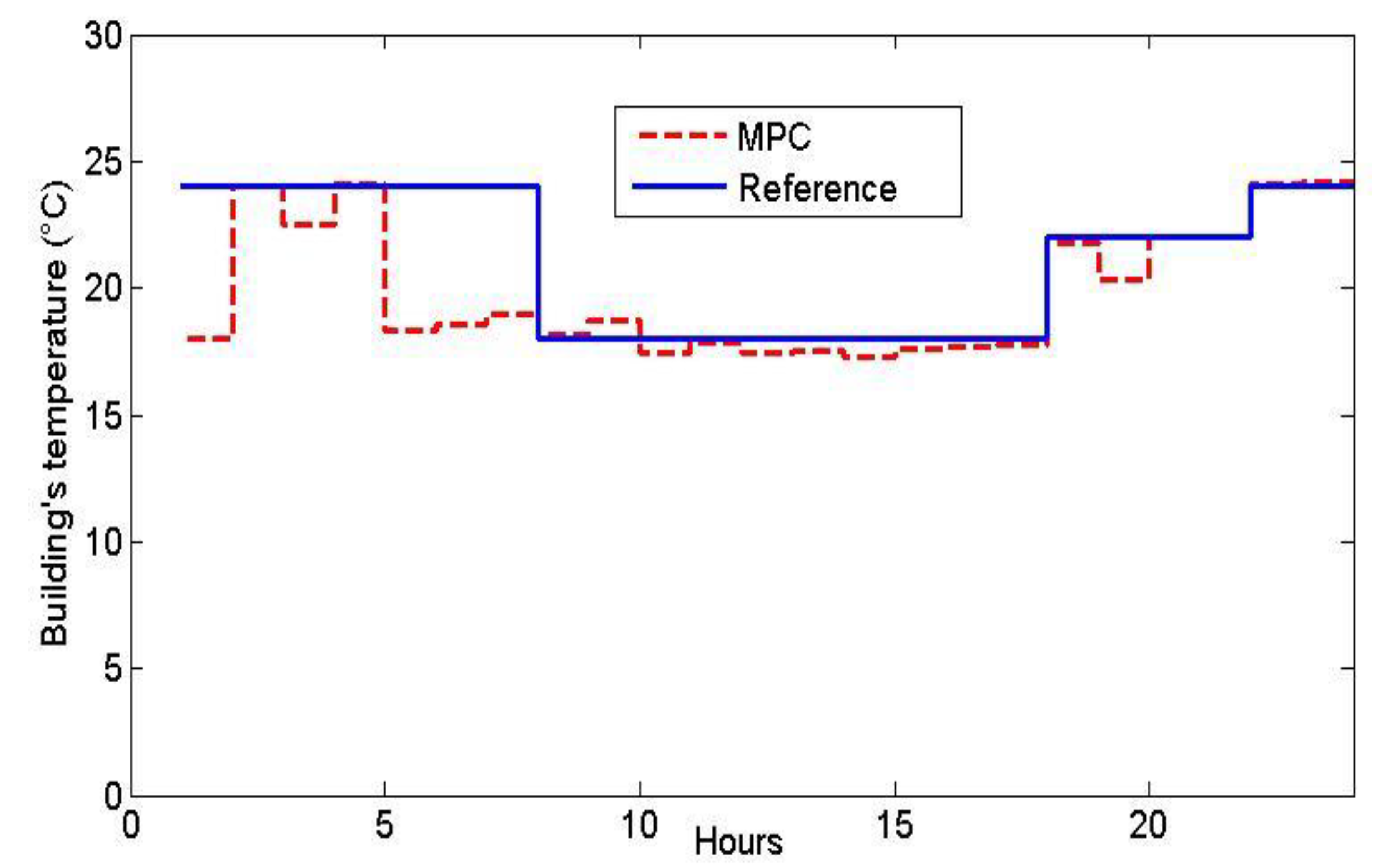
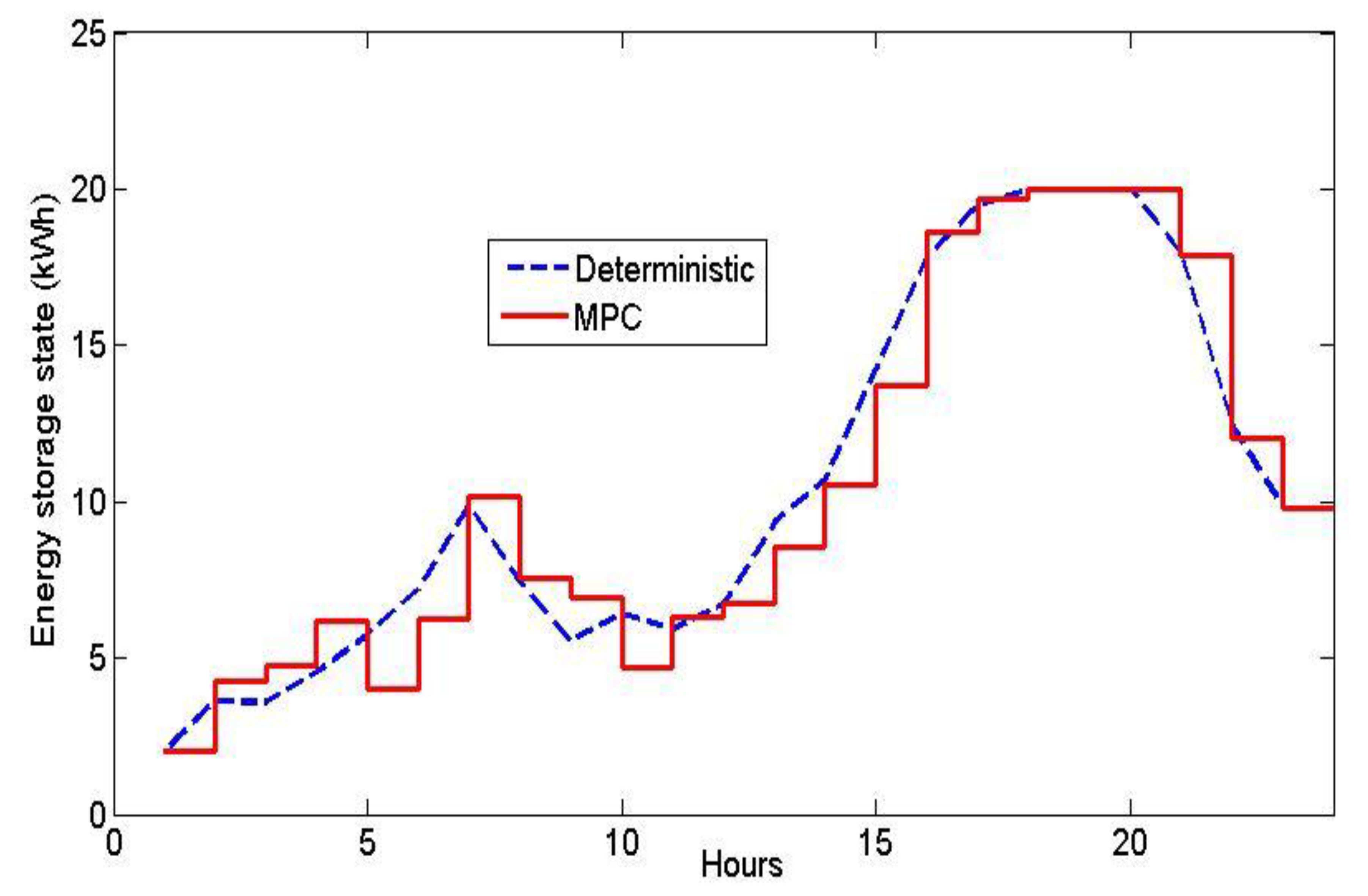
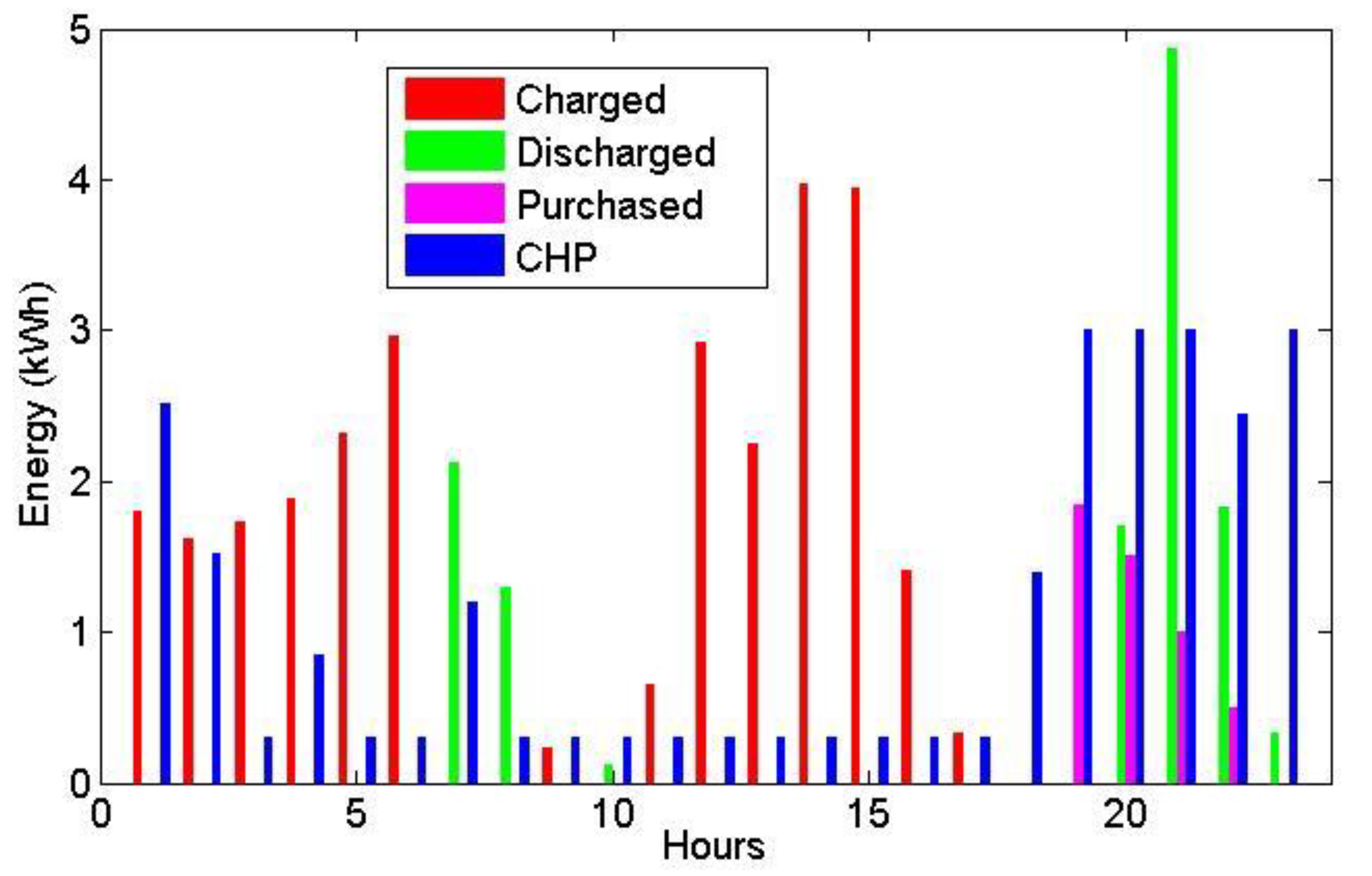

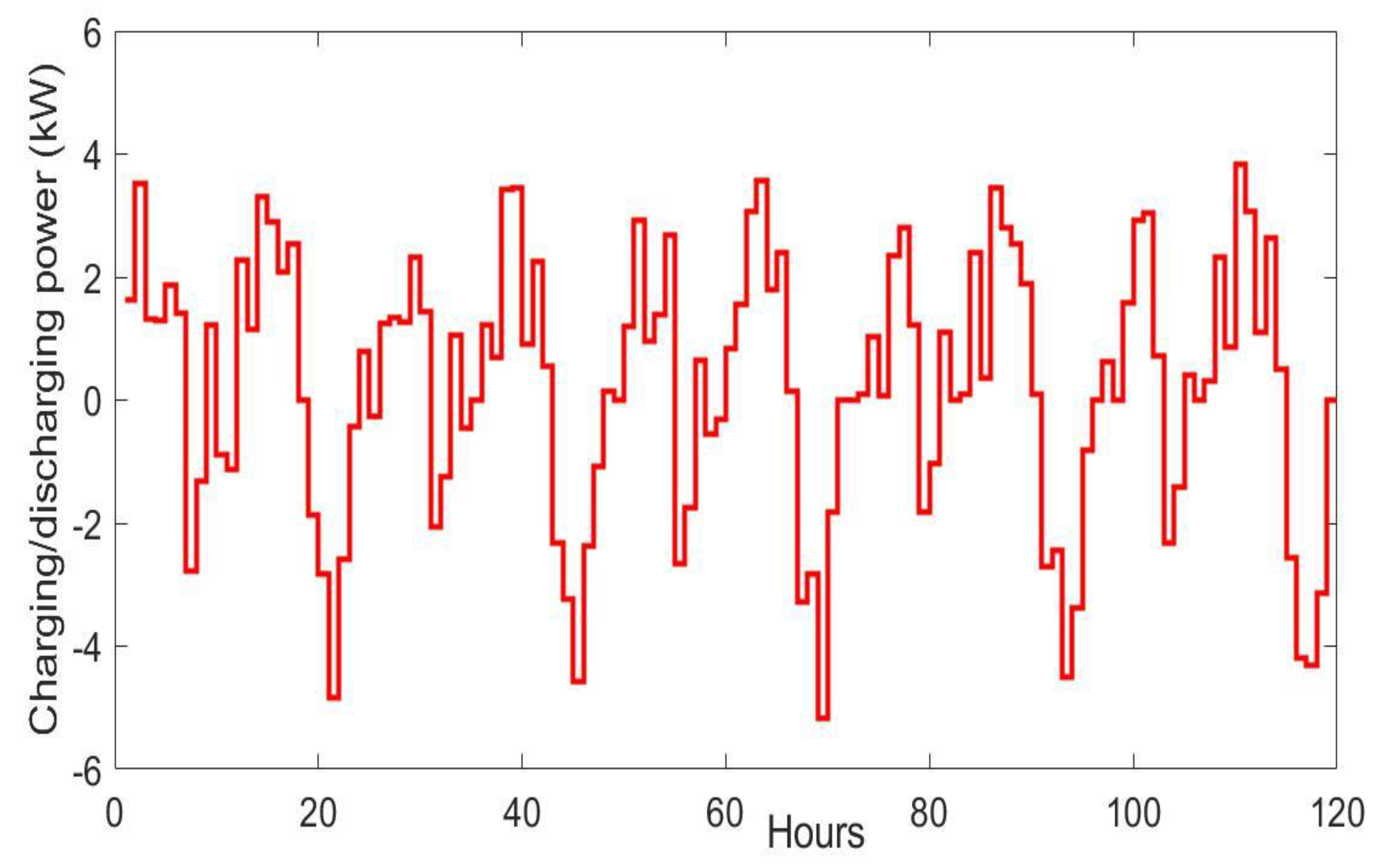
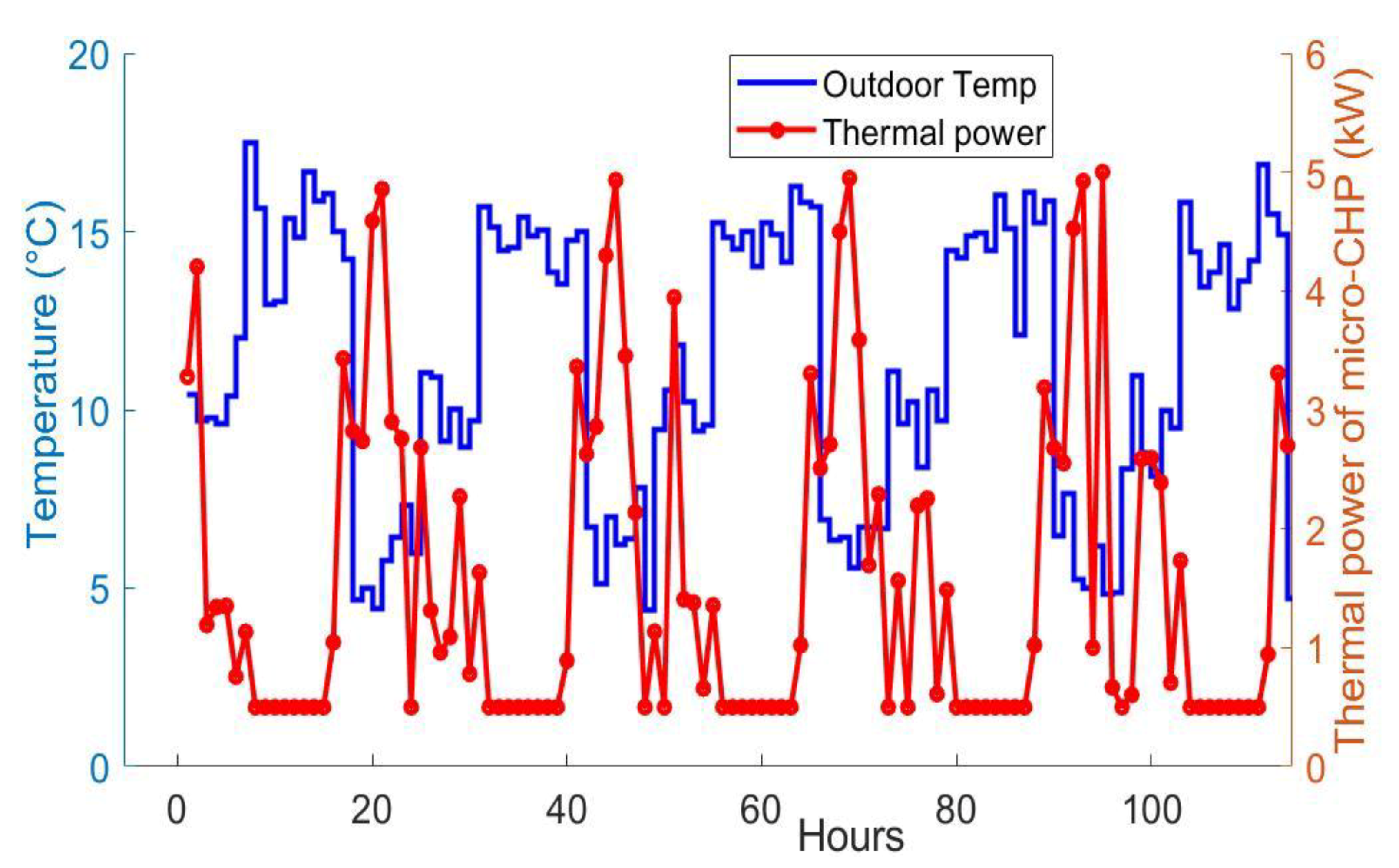
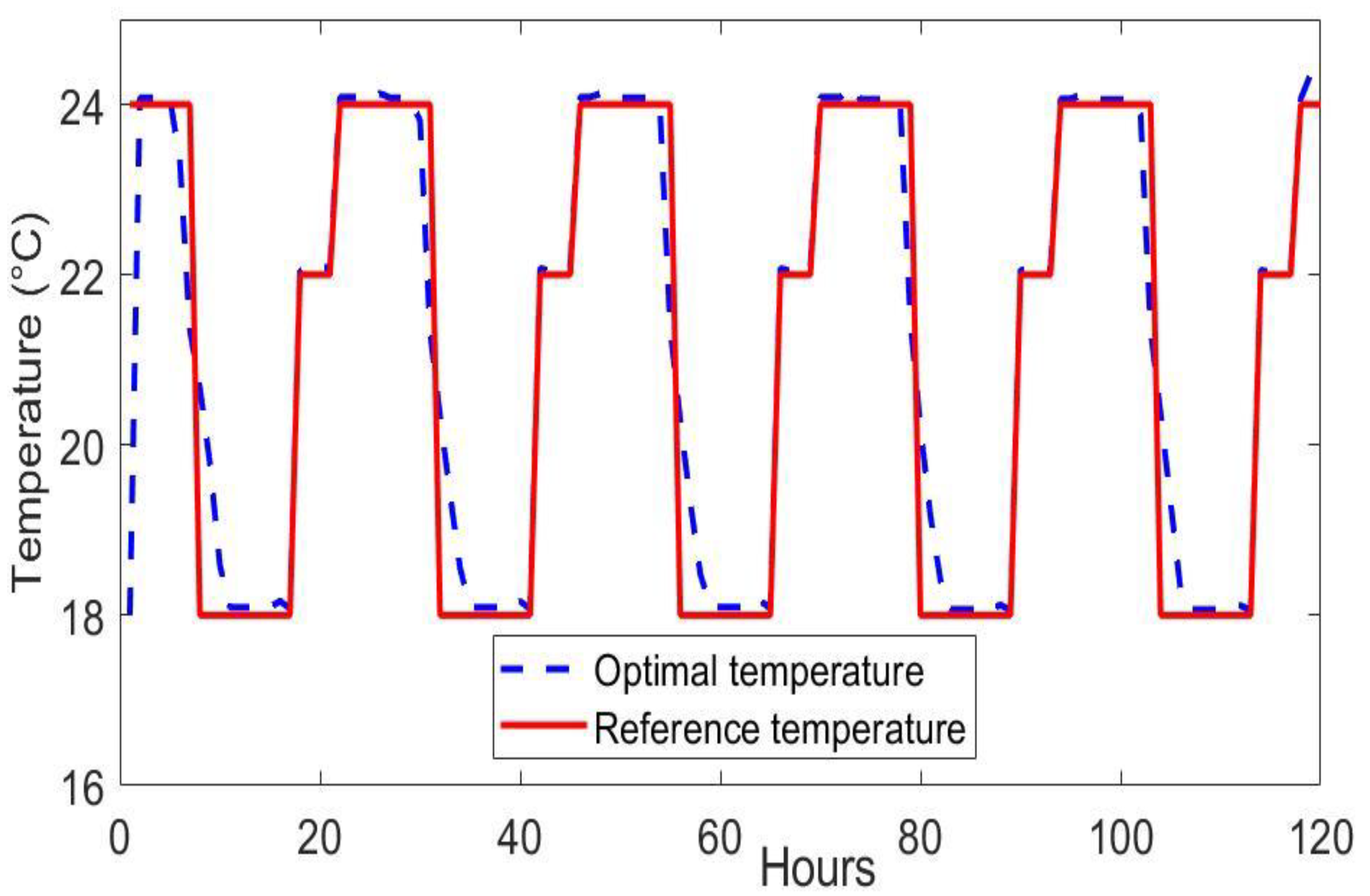
© 2020 by the authors. Licensee MDPI, Basel, Switzerland. This article is an open access article distributed under the terms and conditions of the Creative Commons Attribution (CC BY) license (http://creativecommons.org/licenses/by/4.0/).
Share and Cite
Dagdougui, Y.; Ouammi, A.; Benchrifa, R. Energy Management-Based Predictive Controller for a Smart Building Powered by Renewable Energy. Sustainability 2020, 12, 4264. https://doi.org/10.3390/su12104264
Dagdougui Y, Ouammi A, Benchrifa R. Energy Management-Based Predictive Controller for a Smart Building Powered by Renewable Energy. Sustainability. 2020; 12(10):4264. https://doi.org/10.3390/su12104264
Chicago/Turabian StyleDagdougui, Younès, Ahmed Ouammi, and Rachid Benchrifa. 2020. "Energy Management-Based Predictive Controller for a Smart Building Powered by Renewable Energy" Sustainability 12, no. 10: 4264. https://doi.org/10.3390/su12104264
APA StyleDagdougui, Y., Ouammi, A., & Benchrifa, R. (2020). Energy Management-Based Predictive Controller for a Smart Building Powered by Renewable Energy. Sustainability, 12(10), 4264. https://doi.org/10.3390/su12104264




